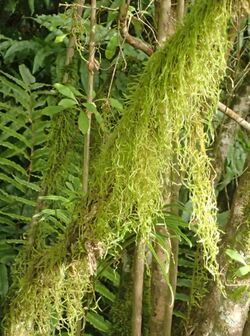Biology:Weymouthia (plant)
| Weymouthia | |
|---|---|

| |
| Weymouthia mollis | |
| Scientific classification | |
| Kingdom: | Plantae |
| Division: | Bryophyta |
| Class: | Bryopsida |
| Subclass: | Bryidae |
| Order: | Hypnales |
| Family: | Lembophyllaceae |
| Genus: | Weymouthia Broth. in H.G.A. Engler & K.A.E. Prantl, 1906[1] |
| Species | |
| |
Weymouthia is a genus of two species belonging to the feather mosses. Weymouthia occurs in southern South America, New Zealand and south-eastern Australia and Lord Howe Island. It is characterised by (i) its monopodial, often hanging growth form; (ii) slight differences between stem and branch leaves; and (iii) the straight perichaetial leaves. In contrast to other genera in the Lembophyllaceae, secondary stems appear unable to arch back to the substrate and then root and form a new creeping stem.[1]
Etymology
Weymouthia was named in honour of William Anderson Weymouth (1842–1932), a prominent Tasmanian botanist.[1] The species epithet mollis meaning soft, flabby, weak or feeble in Latin, refers to the exclusively hanging branches in this species. The species epithet cochlearifolia refers to the spoon-shaped leaves that resemble those of scurvy-grass.
Taxonomy
Weymouthia has traditionally been assigned to the Meteoriaceae, mainly because of the hanging branches. Later the genus was included in the Lembophyllaceae,[1] but according to recent cladistic analyses based on DNA, this family is polyphyletic, and its revision is to be expected.[2]
Key to the species
| 1 | Leaves oblong, more than twice as long as wide; upper laminal cells not or shallowly pitted. → Weymouthia mollis |
|---|---|
| - | Leaves broadly ovate, less than twice as long as wide; upper laminal cells strongly pitted. → Weymouthia cochlearifolia[1] |
Links to photos
References
- ↑ 1.0 1.1 1.2 1.3 1.4 Klazenga, N.; Milne, J.. "Australian Mosses Online. 30. Lembophyllaceae: Weymouthia.(2012)". http://www.anbg.gov.au/abrs/Mosses_online/Lembophyllaceae_Weymouthia.pdf.
- ↑ Merget, Benjamin; Wolf, Matthias (2010). "A molecular phylogeny of Hypnales (Bryophyta) inferred from ITS2 sequence-structure data". BMC Research Notes 3: 320. doi:10.1186/1756-0500-3-320. PMID 21108782.
Wikidata ☰ Q7990394 entry
 |

